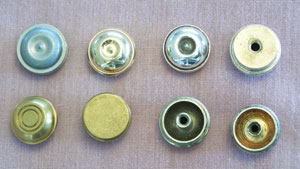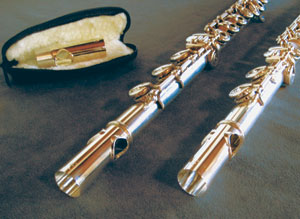The Sound Lesson is one that I teach at least once during a student’s time with me. It includes quick and effective ideas to teach students to hear better and differently. This lesson also helps students who are looking for a new flute. It outlines what is missing in their present flute or headjoint and gives them a clearer understanding of what to look for in a new flute. I also offer some easy and inexpensive tips to help students modify their current instrument for more favorable results.
Bag of Toys
Over the years I have assembled a collection of crowns, Robert Bigio stoppers and crowns, weighted cork assemblies, cork assemblies made of various materials, and two Foster extensions, which I carry in a colorful bag that I refer to as my bag of toys. Each of these items when placed on a student’s flute influences the tone color and response of the instrument. Sometimes the results are great, and other times they are not so good. However, experimenting lets students know if their flute can be improved or if they should purchase a new headjoint or instrument. These experiments also really open students’ ears.
Crowns
In 1996 Jeff Weismann sent me two boxes of headjoints for my students to try. As I looked at the headjoints, I noticed that the crowns were all slightly different, so I tried each crown on my own flute to see if there would be a difference in sound or response. The results were startling.
I did not know why some sounded so much better than others. When a student came in for a lesson, I had her try all the crowns on her flute with the same result.
Her husband owned a computerized lathe and offered to work with me in making some crowns. So one Saturday we started making crowns in brass. First we copied the crowns that had produced the best sound, and then we made crowns of every style and weight. When playing these crowns, we found that the results continued to be mixed.
I consulted a physicist to see if he could make some logic of our primitive experiments. He concluded that the weight of the crown at the end of the headjoint controlled the vibration of the stem assembly. If the stem vibrated too slowly, the tone was spread and diffused, and if the stem vibrated too fast or not at all, the tone was tight. The answer was to find the correct vibration for each flute and flute player. This seemed simple enough. However, the physicist suggested because of the complexity of the problem, it would be best to continue with trial and error.
I own crowns made of silver plate, sterling silver, 14K gold, titanium and brass. Some of the crowns are open (on the inside) while others are plated over.
.jpg)
(Bigio crowns of various materials)
.jpg)
(Stoppers made of metal and Delrin)
In this Sound Lesson, the student tries each crown on his flute and evaluates the results. I begin with the titanium crown because it is the lightest. This shows students that if the crown is too light, the results are not good. Then we continue through all the crowns in order of heaviness. Someplace in the lineup of crowns, the student finds a crown that works well for him. Then we weigh it on a gram scale and try to reproduce the weight by adding weight to an open crown.
If you have an open crown, you can do some experiments by filling in the open area of the crown. My students start with rolled-up paper and then add a base of clay in which to stick a few grains of rice, lentils, or popcorn to increase the weight.
When weighing crowns, we found that a change of .001 grams could be heard in the sound. Rice and lentils are very light, so you can easily control the weight of the crown. If the crown on your flute is a plated or closed crown, you can purchase an open crown for less than $10 at most music stores or repair shops.
.jpg)
(A roll of paper fills the vacant space in the underside of a crown.)
Many student flutes come with open crowns, so if the student still has a beginning flute, he can recycle the crown to the newer flute. After experimenting with crowns, check the cork/stem placement with the line on the cleaning rod. Some of the crowns are heavy enough to dislodge the cork placement.
Stem Assembly
Over the years many craftsman have experimented with replacing the cork on the stem assembly with some other material that is not affected by humidity. Some craftsmen have also experimented with making the whole stem assembly heavier by using a different material, such as brass rather than silver plate. I own several variations of these creations; however, the difference in tone and response is not as apparent as changing the crown.
Bigio’s Crown and Stoppers
The London-based flute maker Robert Bigio and I were communicating about my experiments and decided to exchange examples of our work. He sent me one of his first crown and stopper units. When I placed it in my 1964 Powell, the sound was vibrant and free. The response was excellent too. I encouraged him to market his invention, which he did with success.
The Bigio crowns are either made of Blackwood (grenadilla) or zirconium. The stoppers are made of Delrin or zirconium. Both parts are held in place with an O-ring, an invention that removes the need for a stem/cork assembly.
For many flutes this is an inexpensive solution to improving the sound quality and response. Bigio is not sure why his stopper/crown assembly works, but it does produce outstanding results on many flutes. When playing with Bigio’s invention, players experience a change in the balance of the flute because the headjoint feels much lighter than usual.

(These crowns show the outside and inside. Notice that two are hollow inside.)
Adding a Megaphone
For years I have had students add a small piece of plastic to the end of their flutes to increase projection. To make one, cut a piece of plastic about 2" by 3/4". Place the piece in the end of the footjoint and allow the plastic to extend about an 1/8". Projection and tone color will improve on most flutes. This is an inexpensive solution for a common problem.
Foster Extension
The Foster Extension, which is available in silver or gold, is a small tube-like device that is inserted into the end of the footjoint. It has two tonehole-shaped openings that can be angled up and down or side to side. The extension’s purpose is to improve the harmonic capabilities of the flute by lengthening the flute’s resonanting chamber.

Students hear a difference in the sound of their flutes immediately when the extension is inserted, and many players comment that their tones are bigger and project better. It is possible to use two extensions simultaneously, one piggy-backed onto another, for interesting results. According to Gail Williams, who makes the extensions, they work better on Cooper-scaled flutes; however, I have received excellent results on older instruments as well.
Coda
At the conclusion of A Sound Lesson, most students are surprised at how subtle changes can affect the tone color and the response of their flutes. Often the addition of a bit of weight to the crown improves the focus of the sound and the response.
I have long thought that instrument makers should include several crowns with each flute so that players can choose the best one. This would be an inexpensive endeavor, and if flutists could customize their instruments, makers would sell more flutes.
I applaud inventors like Robert Bigio and Gail and David Williams for asking the big question – how can we make a better flute? It is through their work that we can make expressive music.
Many teachers have asked me how to start a bag of toys. Start by buying a few student-model flute replacement crowns. Each will be a slightly different weight. You will be able to hear the difference from one to the next. If you own several flutes, exchange crowns from one flute to the other. You may find a combination that you like. As long as you are exchanging things, try swapping footjoints from one flute to another. Most footjoints are not the same length so you may find that a longer or shorter one makes your flute more responsive.
For more information about Bigio’s work consult: www.bigio.com/stoppersandcrowns.html. Patent for Foster Extension: www.patentgenius.com/patent/7476793.html.






